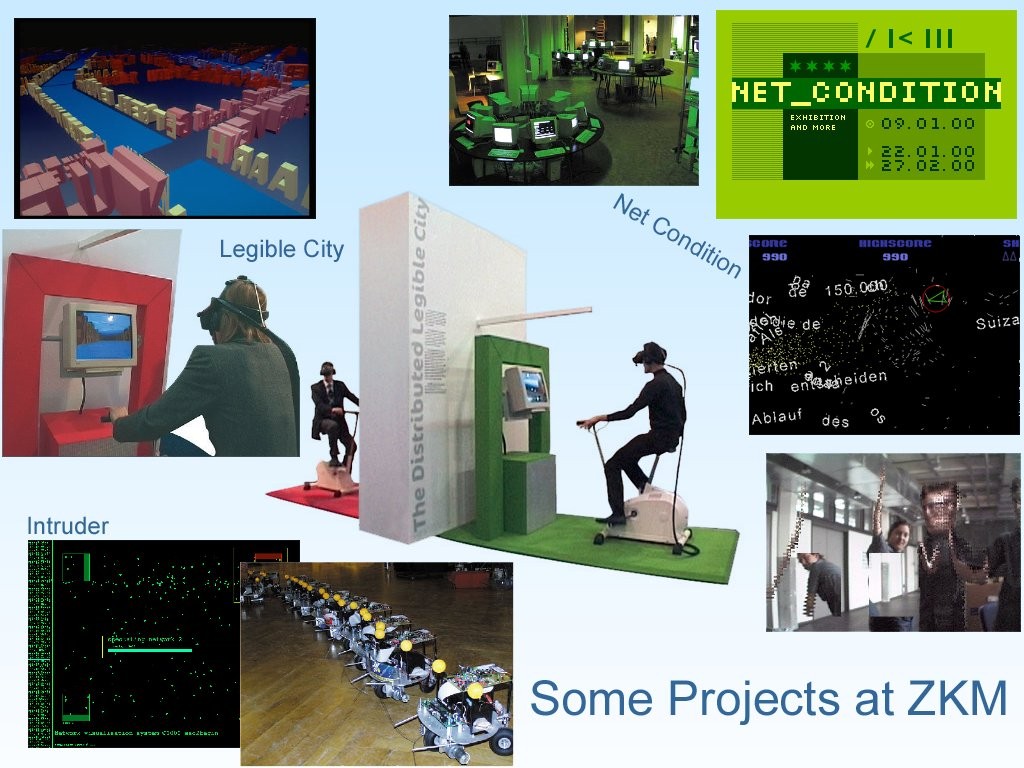This is a collection of various media art projects that I participated in, created myself, or was involved in while I was at the ZKM, or at a later time when I was doing freelance work with various folks.
Intruder
Bernd Diemer’s Intruder exhibition at Weimar, Germany included the operation and control of multiple autonomous robots driving around tracked visitors of the interactive space.
The tracking hard- and software was designed an implemented by me. The system used a IR beam generated at a particular frequency via the Sound-Card of a PC. Multiple IR LEDs are driven by an audio amplifier. The Robots have IR receivers with two independent Tone-Decoder IC on board. Using multiple different audio frequencies, the PC can generate specific trigger sequences received by the robots. The trigger sequences turn on ultrabright, red LEDs arranged in a triangle shape. A video camera with red-filter images the scene and determines the location and direction of the triggered robot from the image. The information is made available via a TCP/IP interface to the control software.
Software
intrudertrack.tar.gz (Linux software, .tar.gz archive, 13K)
Images

Building the Robots at the ZKM
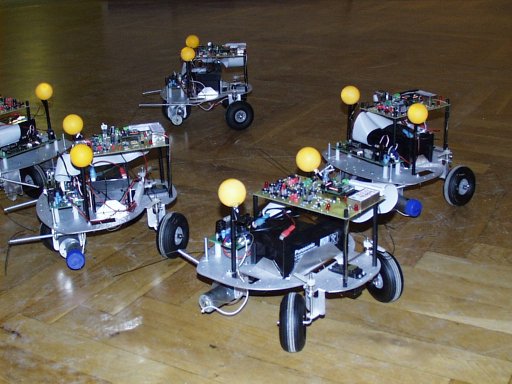
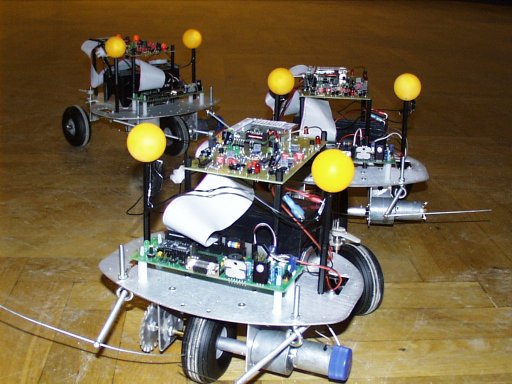
Operating the Robots at the Weimar Show
The Distributed Legible City
3D navigable Environment with physical interface (bike) and collaboration interface (audio/visual).
An extension of J. Shaw’s “Legible City” was implemented by me at the ZKM. The new hardware was designed to be using PCs (to keep costs down) and 3Dfx’s SLI Voodoo2 video cards (the best at the time) to replace the aging SGI infrastructure. The code-base was rewritten as an OpenGL based program. Extensive audio communication capabilities were included via a custom hardware mixer that was controlled via a central server. The audio signals were to come from special Modems with an audio&data channel.
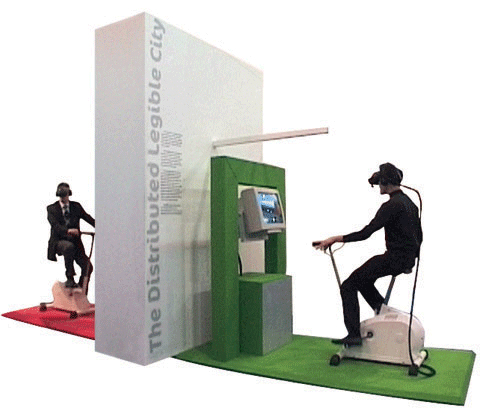
Documentation
- DLC-Scans.zip (scanned images of the electronics for DLC, .zip archive, 342K)
Switched Video
A Virtual Architecture Video Installation.
For this virtual architecture installation, the libbgrab library (multithreaded framegrabber lib for bt8x8 chips under Linux) was interfaced with some alarm mats under a carpet via the parallel port triggering live-video or still-video in bands from a camera.
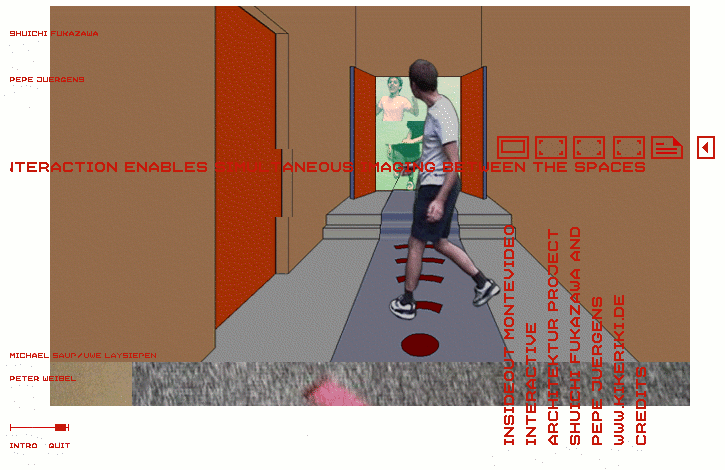
The installation of this system was presented by Shuichi Fukazawa.
Global Bodies (1997)
A distributed information event for the ZKM Media Museum opening event.
I set up some of the server infrastructure to gather and distribute information during the ZKM opening event Global Bodies. One of the interface elements was a pseudo video stream, a sequence of images coming from a FTP upload server and presented in Netscape for any visitor.
J. Birringer from Houston writes “… the image streaming on the ZKM website worked perfectly …”. A simple but robust script based CGI setup and a solid Linux installation made that possible.
The system kept serving images throughout, but the server load crept up to 25 from time to time … serving thousands of concurrent external visitors (rather than only the intended GlobalBodies participants) was too much for our Pentium 200 box … who posted that URL publicly?
A CD-ROM features most – if not all – the material that was gathered on the ZKM Server on the 18th and 19th of October 1997 during the Global Bodies Event.
 GlobalBodies.iso.bz2
GlobalBodies.iso.bz2
(ISO image, .BZ2 compressed, Size 391 Mbytes, for Windows 3.11/9x/XP
Some of the interesting questions posed at the event to participants:
1. Are our eyes our Targets?
2. Do we become what we see?
3. How do you think technology will change our body?
4. How many personalities do you think you have inside you?
5 Are sounds born, do they also only spend a lifetime in certain places and then die?
6. Are we already Cyborgs?
7. What is the difference between genetic memory and cultural memory?
8. How do you think it would feel to be touched throughout the network?
9. What percentage of your being is connected intimately with technology?
10. Can the human Body be an interface?
11 How do we determine whether an entity is conscious?
12 Is intelligence the allowance to decide what it considers to be useful for itself?
13. Do you fear Machine Intelligence limiting your free will?
14. How does the constant use of technology effect our thought processes?
15. Which is worse for you….alone in a room with Email or a room filled with people but no Net connection?
16. Do you believe in virtual sex?
17. What is your definition of _Nature_.

A few things have to be mentioned:
To start the CD-ROM, double click on the “startw31” or the “startw95” icon, depending on your operating system. You don’t need to have any special software installed, but some parts will remain unavailable if you don’t have Quicktime, DirectX or Netscape installed.
When you start the CD-ROM, you will see an intro that runs in a loop. To go on, press the mouse button. You navigate the CD-ROM by clicking on any red box. Some clickable areas are identified with a hand cursor. To quit, press the escape key or choose quit from the menu. You can return to the interface with the “main” menu button or the “Global Bodies” box. “intro” will run the intro loop
System Requirements:
– Windows 3.1 (Windows 95 recommended), 256 Colors, 640×480 screen size
– Speakers or headphones for music and soundtrack
– Quicktime installed
– Netscape 4 installed
– DirectX installed
You can find the most recent versions of the required software for Windows 3.1 and Windows 95 in the “install” folder on the CD-ROM.
In order to view the included websites, you will have to install Netscape on your computer. There is no need for an online connection, but some of the material will be unaccessible if you view it offline.

Thanks to the production team: Bernd Diemer, Markus Lacher, Andreas Schiffler, Jill Scott, Wanda Webb
Smart Apron
Using wearable computing to create a smart apron to improve the working conditions of foreign domestic workers.
I’ve worked with Margaret Tan (Singapore) on this Project entitled “Smart Apron”.
The Project was part of the (Artists-in-Labs) AIL Program: Many artists currently explore the scientific, technological and cultural developments of the 21st century and they are engaged in critical and ethical debates. The intention of the AIL program is to share common goals, to broaden the dialogue, generate ideas and raise awareness of the contributions both artists and scientists can make to the larger challenges of our time.
Images
Software
- apron.command (.pl)
Presentations
- AIL Symposium 2005 (.pdf)
Additional MacOSX software used:
mpg123-0.59r.pkg, Perl 5.8.0, August2003gccUpdater_Build6K472_061-0746, Dec2002DevTools CD, joe Editor 2.9.8 ZTerm1.1b7
eSkin Phase1 (2003)
The goal of this project was to build a set of artifacts for an interactive and collaborative installation that mimics aspects of human somatosensation. By this way a fundamental form of bodily experience is brought into an interactive system.
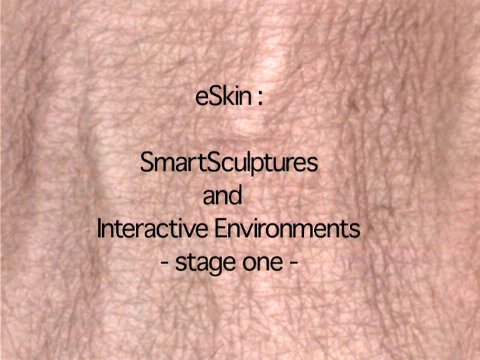

Design and programming of three wireless interface-prototypes. Each interface possesses a surface that is sensitive to pressure, vibration, and temperature. Users interact with the sculptures by touching and carrying them around. Tracking and sensor information is distributed to several different computers that transform user interaction into visuals and acoustics, creating a collaborative synesthetic experience.
Software
- Smart Sculptures Software (115K, .tar.gz)
Documentation
- eSkin Brochure (.pdf)
- eSkin Report – Stage 1 (.pdf)
Videos
- eSkin DVD – Stage 1 (89M, Xvid, .avi) – might require the Xvid plugin
eSkin Phase2 (2003)
Prototype development aimed at building both functional and design models of a wearable and ergonomic interface which helps in navigating complex environments and obtaining information on objects present therein.
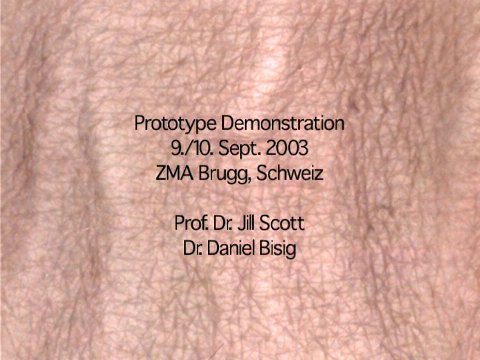
During the time preceding the KTI feasibility study, a portable e-Skin interface prototype was developed by the project partners. This early prototype allowed us to study how the skin based modalities of touch, vibration, temperature and proprioception could be sensed by an interface and how these modalities could be used to control multimedia environments. In order to explore how this interface could be augmented into a navigation and information aid for visually impaired and normal people, a further prototype development phase was undertaken during the last months of this feasibility study.
This prototype development phase aimed at building both functional and design models of a wearable and ergonomic interface which helps in navigating complex environments and obtaining information on objects present therein. The two most important requirements which had to be met by this interface prototype were:
– provide feedback through modalities which are particularly useful for visually impaired people
– integrate and rely on technical infrastructure which will eventually become predominant in public and private spaces
Documentation
Software
Server
Zaurus
Future Bodies (2002)
Future Bodies are nomadic text- and visual-based entities, floating in cyberspace, waiting for interaction through the net. These characters, who live in cyberspace, create an interactive, non-linear, net-based hyper drama which the viewer can influence.
The proposal for Phase 2 was designed to bring the paradigm to a wider audience.
View Proposal …
Themenpark Expo 2000 (1999)
Assistance in the concept and simulation of the “Swarming Robots” mobile projection platform was given for the World Exhibition 2000 in Hannover, Germany.
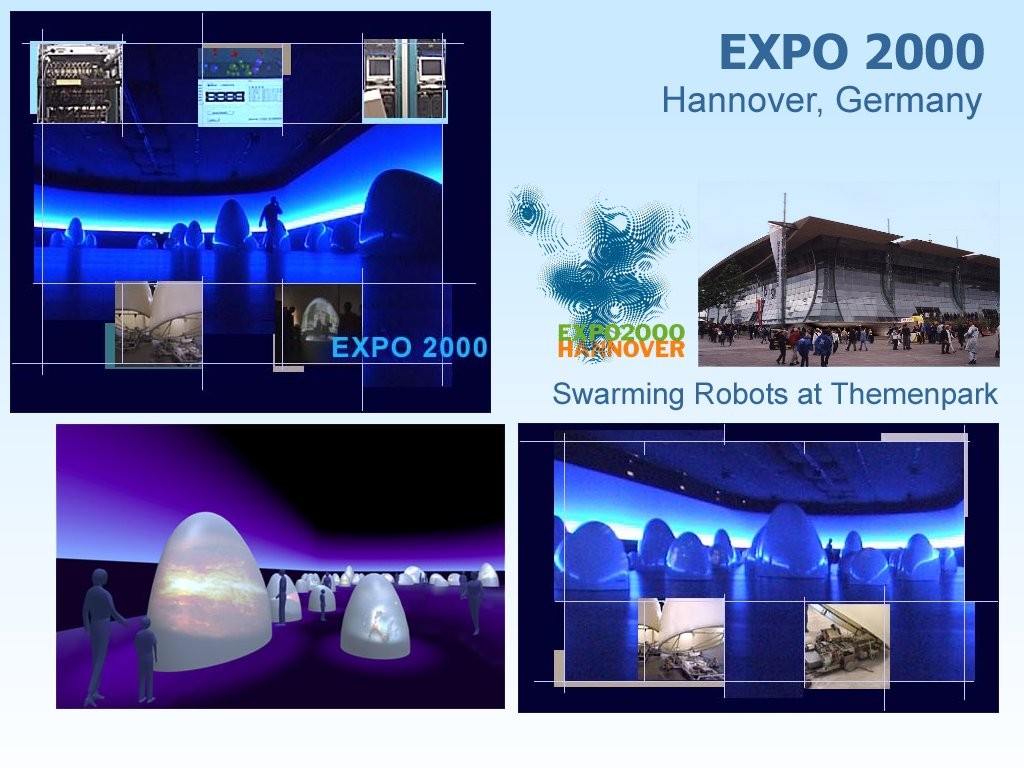
Images
- Software Module Layers – Diagram (.gif)
- Rendering of Exhibition Display 1 (.jpg)
- Rendering of Exhibition Display 2 (.jpg)
- Rendering of Exhibition Display 3 (.jpg)
Links
- Expo2000 Exhibition Website (external link)
- ZKM Article (external link)
the_robots Software
Simulation of autonomous robots and an interacting audience in a hall. C/OpenGL-source and screenshoots.
IO_Dencies Biennale 1999
In conjunction with the well established art group Knowbotic Research, an interactive, force-feedback information visualization was created and exhibited at the Biennale in Venice, Italy.
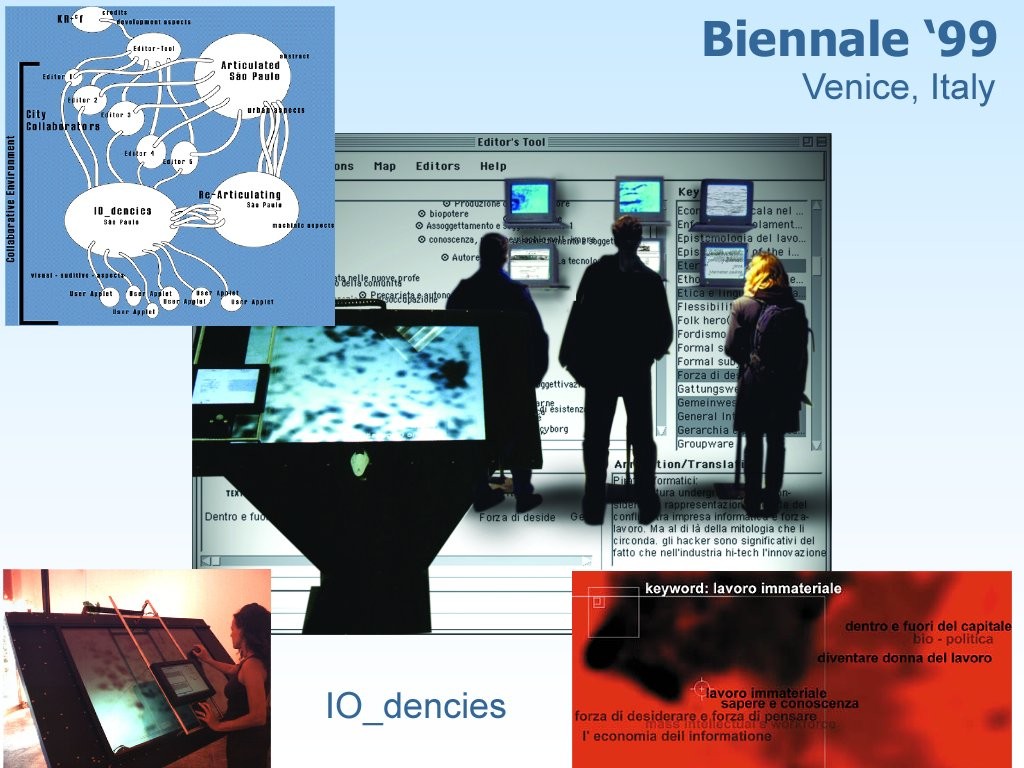
Documentation
- “Cover Art” of Installation (.jpg)
- IO_Dencies Software – First Overview, A. Schiffler (.pdf, 206K)
- IO_Dencies – Space in the Third Millenium, Roemer van Toorn, Amsterdam, 1998 (.pdf, 844K)
- IO_Dencies Homepage (external link)
- IO_Dencies System description (.pdf) (.doc)
- EScape Project Report (includes IO_Dencies) (.pdf)
Frankfurt Airport Installation
Camera tracking software development for a public interactive art installation at the Frankfurt International Airport in Frankurt, Germany. Custom software development with multi PC setup and MIDI control.
Images
- Diagram for placement of cameras (.jpg)
- Motiontracking Diagram (.jpg)
- Rendering of Installation (.jpg)
Prada Tokyo VR Window
System design for a proposed virtual reality window for the Prada Tokyo “epicenter store”. Hardware and software design were conducted for the media art school Hyperwerk in Basel, Switzerland.
Images
- ARtoolkit Development shot 1 (.jpg)
- ARtoolkit Development shot 2 (.jpg)
- ARtoolkit Development shot 3 (.jpg)
- Augmented Reality Window Site (.jpg)
- Shopping-bag Tracker Presentation (.jpg)
Software and Documentation
- ARtoolkit – Prada version (.zip)
- Prada Software Installation Notes (.pdf)
- Tracking Range Diagram (.png)
OMA Box/Statement Station
System design for a mobile recording studio “Statement Station” in conjunction with coaching students and at the media art school Hyperwerk in Basel, Switzerland.
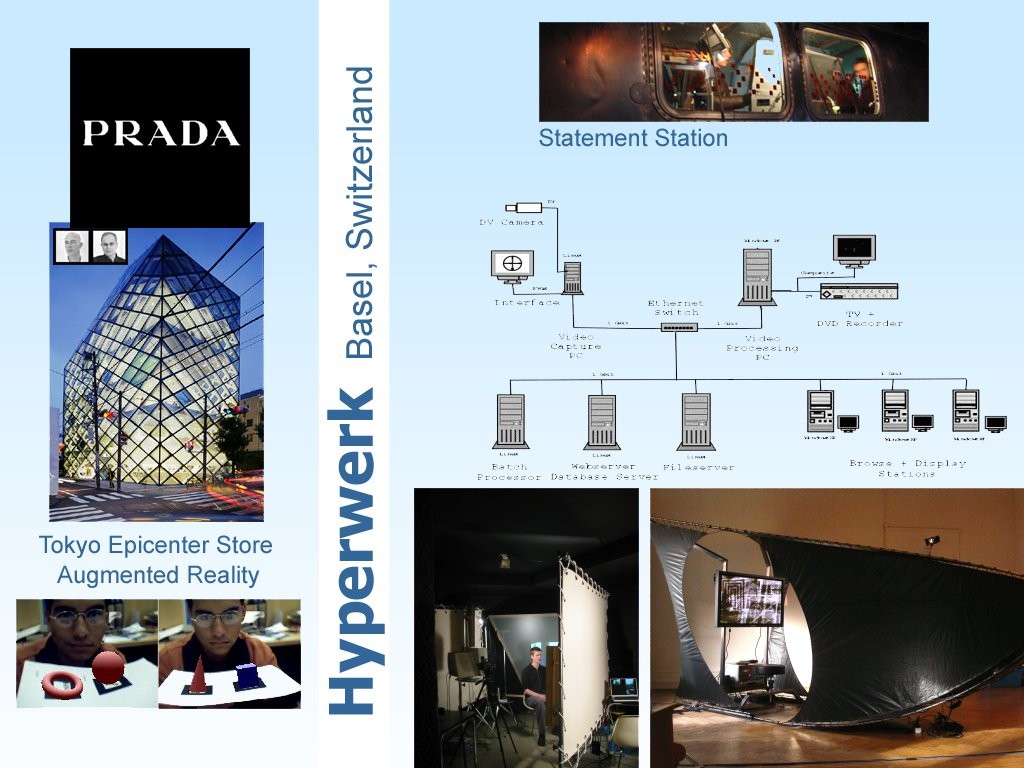
Links
- Statement Station Installation (.jpg)
- OMA Design Ideas (210k, .pdf)
- Statement Station Capture Application, v1 (214k, .tar.gz)
- Statement Station Installation File List, v1 (295k, .zip)
- Statement Station Installation Notes (139k, .pdf)
Vergence
Multi-User-Onlinespiel im Deutschen Pavillion auf der EXPO2000 Hannover
Esc to begin präsentiert mit “vergence” die neueste Generation der vernetzten Online-Spiele, in denen technologische Innovation mit kommerzieller Spielegeschichte gekoppelt wird. Auf den frei zugänglichen Serverknoten von esc to begin in Karlsruhe, Wien und Frankfurt können über 15000 Teilnehmer an verschiedenen Onlinespielen aus fünf Kategorien im Internet teilnehmen. Erfahrene Spieler können an den laufenden initgame-Turnieren teilnehmen, und für Neulinge öffnet sich ein einfacher Weg, um Online-Spiele zu erleben. Bei initgame zeigt die Netzparty-Community dem Betrachter die rasante Welt der globalen, vernetzten Spiele.

The interface to “delaygrab” and other
components of “Vergence”
Gespielt wird, was gefällt. Auf der Website (ab 1. Juni 2000) werden in einem bei ZKM.Online entwickleten System die gerade laufenden Spiele und Spieler angezeigt. Im Online-Chat können sich die Spieler verabreden, am laufenden Spiel teilnehmen- oder selbst ein neues, weltweites Spiel starten. Die dabei entstehenden Verbindungsdaten werden zentral gesammelt und formen die Datenbank des EXPO-Interfaces: Die Installation im Deutschen Pavillion ermšglicht es 200 Besuchern gleichzeitig, sich mit einem intuitiven Benutzerinterface vor Ort an diesem globalen Spiel zu beteiligen, es zu beobachten und in den Ablauf einzugreifen. Die Online/Offline-Benutzer handeln gemeinsam, am Bildschirm wird gespielt, geretten und erobert, in der realen Welt wird der Besucher zu einer Reise in die technozide Mediengeschichte verfŸhrt. Die einzelnen Terminals wandeln sich zu Navigationsinstrumenten, mit denen die spielerischen Ebenen des Interfacedesigns, der kuenstlichen Intelligenz und der Datenvisualiserung gezeigt werden.


The real-time “delaygrab” video processor
(part of libbgrab) at work
Visuell zeigt sich der Fluss der Daten durch die Serverknoten und die Schnittstelle auf der EXPO in einer fluiden Bilderwelt. Jedes Interface erhält einen Datenblock aus dem abstrakten digitalen Strom und verarbeitet ihn parallel. Aus Onlineservern, globalen Netzwerkspielen, lokalen Interfaces und Benutzerinteraktion ensteht eine Einheit, die veränderten Datenblöcke werden berechnet, zusammengefügt und auf Grossbildprojektionen angezeigt. Die simultane, unabhängige Entwicklung von verwandten Systemen in einer gemeinsamen Umgebung formt eine Divergenz/Konvergenz [vergence] im zentralen Fokus.

“Vergence” online visualizaton (concept)
esc to begin:
Esc to begin ist eine neue Abteilung innerhalb des Zentrums für Kunst und Medientechnologie. Geleitet von Bernd Diemer arbeiten hier 4 junge Stipendianten seit Anfang 99 unterstützt von freien Mitarbeitern, Volontären und Praktikanten an derzeit neun Kunstprojekten aus den Bereichen Robotik, künstliche Intelligenz, Echtzeitvisualisierung und digitalen Spielen. Ziel ist hier die Verbindung von angewandter Grundlagenforschung mit experimenteller künstlerischen Arbeiten sowie industriellen Ansprüchen. Esc to begin zeichnet sich aus durch eine hohe Produktivität, praxisorientierter transdisziplinärer Arbeit und eine breit gefächerte Fachkompetenz im wissenschaftlichen und künstlerischen Bereich.
core: Bernd Diemer, Martina Haitz, Andreas Schiffler, Guillaume Stagnaro
temp: Sue Machert, Arne Grässer, Meike Schmidt, Andreas Krach, Douglas Edric Stanley, Dirk Heesakker, Miriam Haitz, Crispin Fütterer, Markus Bekk, Daniel Pölzleithner, Susen Kümmel, Sanja Hügel, Shuichi Fukazawa
net_condition (1999)
Contribution to an exhibition of net-art in the Center for Art and Media Technology (ZKM) in Karlsruhe, Germany.
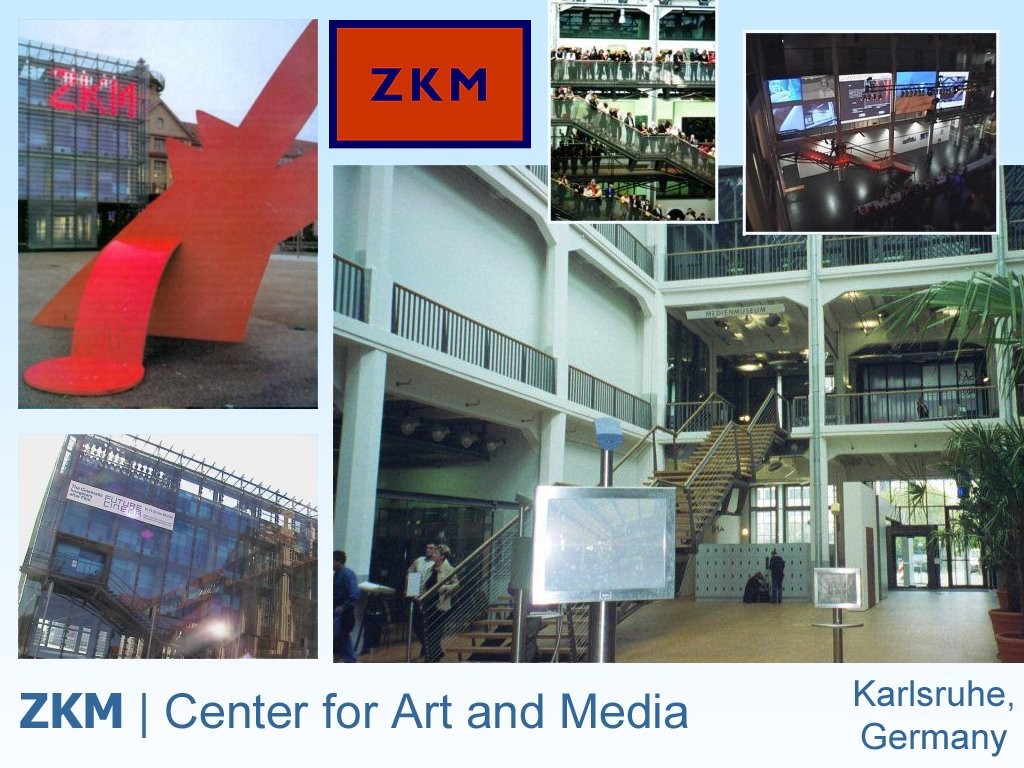
I was involved with several pieces at the net_condition exhibition at the ZKM 1999-2000. Some of my software at the show included my game FAST, asciivideo, and activity-to-MIDI sound mapping using the asciireflector.
Below are some game-pause images from our ESCtoBegin group.



videowall (1998)
For the ZKM installation “Digital Body Automata” a realtime “blue-screen” driver software was used to build an interactive videowall made out of 16 TVs with interactive content on 12 of the screens.
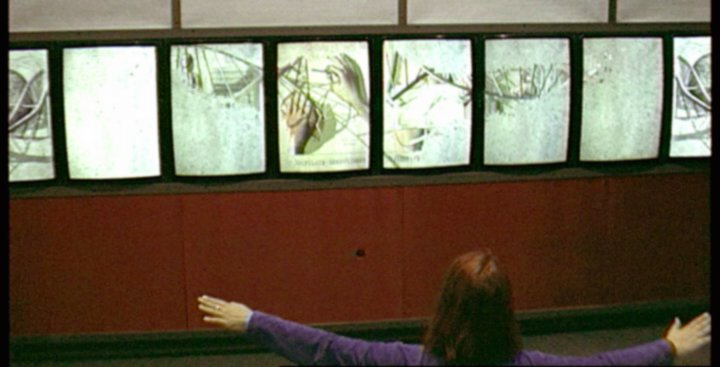
System components were:
– 2x 8 TV screens arranged in a row on each side of the mural
– 5 Pentium200 PCs with 3 Matrox VGA video cards each and a Matrox Meteor framegrabber card
– 4 cameras imaging a red cloth screen below the TVs
– multiple VGA-to-TV converters, video splitters, cables, etc.
– RedHat Linux and custom X-Server that supports 3 video cards (needed at the time)
Source
- videowall-2.0.tar.gz (Linux source, 9K)
The TVs shows a cover image (stone texture). When the observer enters the space, a virtual shadow is cast onto the TVs revealing a detailed image underneath. The “shadow” is calculated from the obscured red sloth in the image path of the tiny wide-angle cameras hidden below the TVs.
beyond
Control program and “driver” for the multimedia installation for Prof. Jill Scott’s “Beyond Hierarchy” (Dortmund, Zeche Zollern, Summer 2000).
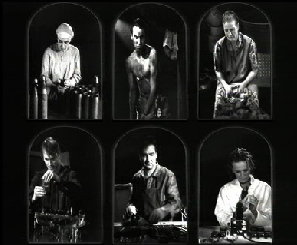
Driver for the multimedia installation for Prof. Jill Scott’s “Beyond Hierarchy” (Dortmund, Zeche Zollern, Summer 2000).
- Video Documentation (YouTube)
- Project Description (external link, german)

Wiring Diagram
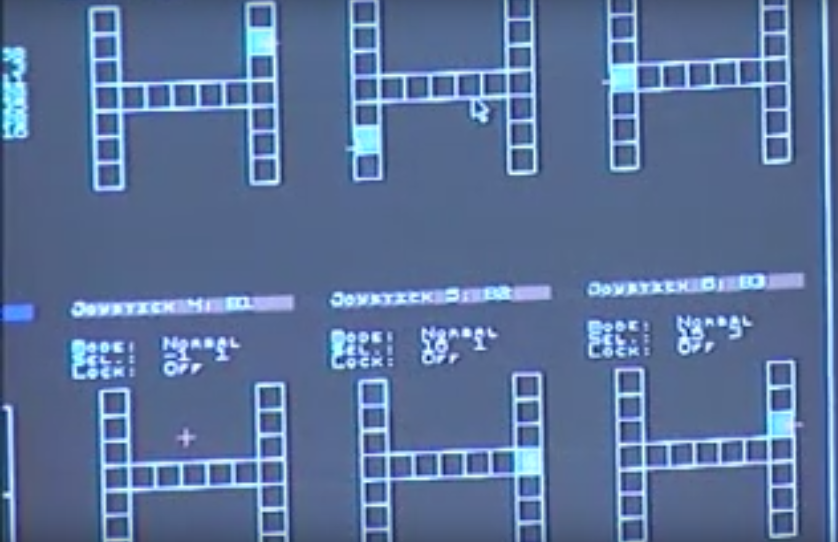
Joystick Control Display
DOWNLOAD
Fusion 2001 – Recordings (2001)
Noise-recordings of Niagara Falls with a directional mic for internet streaming and subsequent sound synthesis by distributed sites for Fusion 2001.

Links
10000miles
Concepts and prototypes that were created for Michael Schmitt’s 10000miles.de Project.
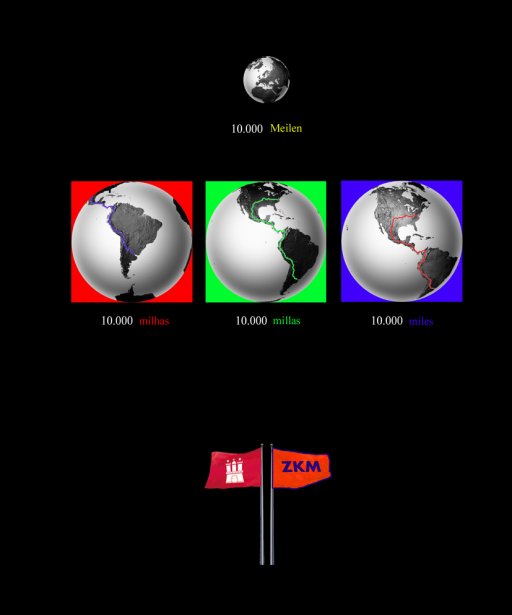
As part of the project I’ve developed some travel-oriented interactive games, including a “Suitcase” KiSS and some ASCII art.
Links
- ZKM Kiss – Suitcase Game (interactive Java applet)
Images
- Language Selection (.jpg)
- ASCII Video (.jpg)

